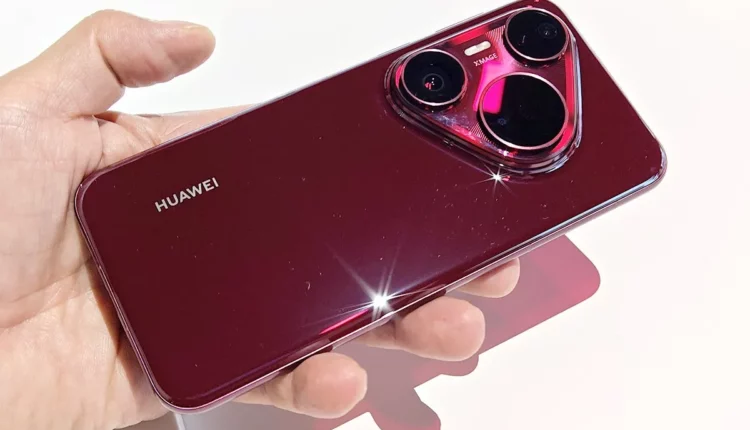©2021 Reporters Post24. All Rights Reserved.
Although Huawei ‘s presence in the global smartphone market has waned, its technological capabilities continue to evolve, including the world’s first three-fold model. Huawei’s flagship smartphone, the Pura 80 Ultra, is the first smartphone in the world to offer a camera function, and it has attracted a lot of attention in the industry.
Huawei’s flagship smartphone “Pura 80 Ultra” review

The Pura 80 Ultra is distinguished by its distinctive rear design. It has three cameras, but in addition to the camera bump with a triangle design, the middle lens is quite large, making it hard to believe that it is a smartphone. The triangle design of the camera is familiar from the Pro series of iPhones, but the back of the Pura 80 Ulra looks completely different from such iPhones.

The Pura 80 Ultra is also available in the global market, although it does not have Google Services (GMS). It will be launched first in China in June 2025, with Huawei-developed HarmonyOS as the operating system. A global launch event was held in July, and sales began in Southeast Asia and other countries. The global model is equipped with Android-based EMUI OS. Some GMS is also available, albeit unofficially, and to some extent, major apps can be downloaded.

The Pura 80 Ultra’s specs are…
- Display: 6.8 inches (2,848 x 1,276 pixels)
- Battery: 5,700mAh (for China), 5,170mAh (for global markets), 80W fast charge support
- Chipset: HiSilicon Kirin 9020
Due to U.S. sanctions, the chipset cannot be manufactured with the latest process rules, and the Kirin 9020 is 7 nm, a process designed several generations ago.

The overall performance is not bad, and this can be attributed to the OS optimization. However, movement can be a bit sluggish in high-end games that make heavy use of graphics. While this phone is high-performance enough for general smartphone use or as a camera phone, it may not be suitable for purchase for gaming use.

The body comes in gold and black color variations. The black model is also decorated with a gold edge for the camera lens. This triangle design was also used in the Pura 70 Ultra a year ago, and we often see users of this design when we visit China. The Pura 80 Ultra also comes in four models in the series: Pro, Pro+, and unbranded, all of which are very popular in China.

As for the camera, its performance is on par with the high-end models of other companies, but the camera module portion is considerably larger. The body size is 163.0 x 76.1 x 8.3 mm and weighs 233.5 g. Incidentally, Apple’s iPhone 17 Pro Max weighs 233 g.

The camera features a 50-megapixel, f/1.6-4.0 wide-angle, a 40-megapixel, f/2.2 ultra-wide-angle, and a telephoto with dual periscope focal length support. The 3.7x 50-megapixel, f/2.4 telephoto lens becomes a 9.4x, f/3.6 high-power telephoto by sliding the prism. Note that the f-stop at this time is f/3.6. If you look closely at the largest lens, you will see two lenses inside. These lenses correspond to the 3.7x and 9.4x positions, respectively, and the prism module slides inside to change the focal length.

The camera uses Huawei’s proprietary XMAGE imaging technology. The AI adjusts the camera to reproduce natural colors rather than flashy ones. Although the camera’s AI processing can be a little sluggish in night scenes and high-magnification telephoto shots, the image quality itself is among the best in the industry.

The same scene was shot at 3.7x. Even the smallest of details are well represented. The green tints and other details are also well represented.

This is a 10x magnification. The periscope camera switches to 9.4x and digitally corrects the image to 10x. Although the pixel count drops to 12 megapixels, it does not seem to be a concern during the daytime.

This is digital 30x shooting. It should be sufficient for viewing on a smartphone screen. At 30x or more, the camera’s preview screen is displayed as “entire image + magnification,” making it easier to follow the subject of interest. The maximum magnification is 100x, and since AI correction is applied considerably, I was able to capture a fairly “viewable” image.

Since we tested the device at the launch event in Bangkok, the OS was EMUI as mentioned above. The UI structure, icons, etc. are fairly integrated with the HarmonyOS for China, and are indistinguishable at a glance.
As for GMS, I wrote “unofficial,” but in fact, major applications (Play Store, Gmail, YouTube, etc.) are pre-installed via micro G (an open source Google Play Developer Services alternative). There may be some functionality limitations, but it will be roughly usable.

In addition, there are approximately 3 million apps offered on AppGallery, Huawei’s app store. Considering that Google has about 4 million and Apple about 2 million, they are evenly matched, but in reality, there is little support for major apps, and only a few SNS-type apps are served globally. A few years ago, Line support was also lost. If you want to use a Huawei smartphone “now,” it is practical to use a micro G or similar device and install apps from Google’s Play Store.

The latest HarmonyOS NEXT completely breaks away from the Android and Linux kernel and uses a kernel developed by Huawei. Therefore, applications via GMS or Play Store cannot be installed. However, there seems to be a way out, such as using an emulator to install them. With only a few tens of thousands of apps compatible with HarmonyOS NEXT still available, Huawei’s smartphones seem to have some concerns about OS trends in contrast to their high hardware performance.
The Pura 80 Pro, one model below the Pura 80 Ultra, has a similar body design, especially the red body model. The Pura 80 Pro has a 4x 48-megapixel telephoto camera, but other specifications are the same. You may choose this one based on body color.
Neither model is scheduled for release in Japan, but it is important to know that Huawei’s camera technology is still capable of holding its own on a global scale.


